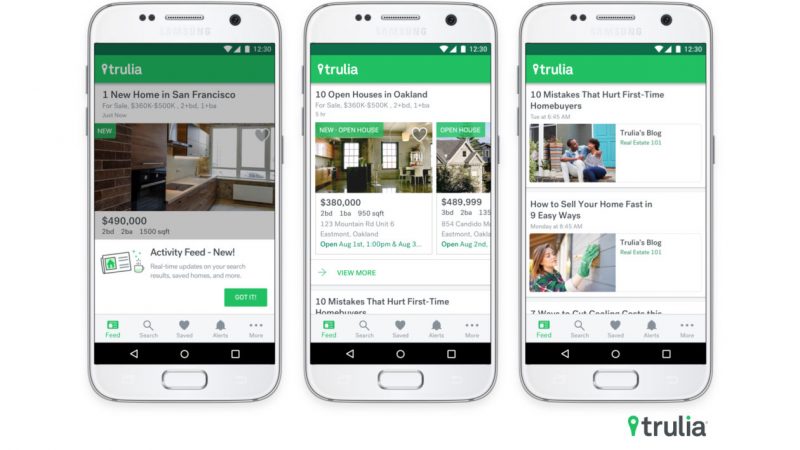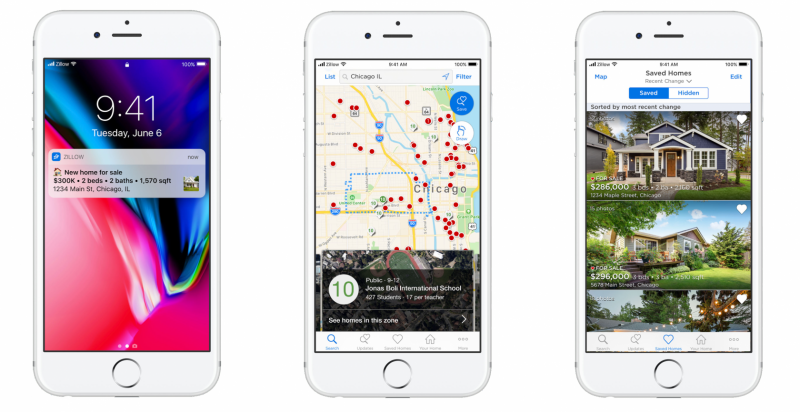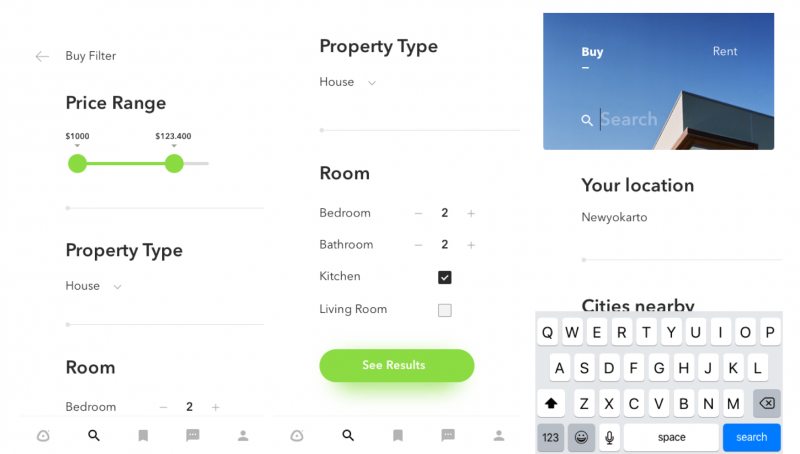The introduction of new web and mobile services has shaken up the regimen of real estate industry. While some still prefer house hunting the old way, the majority has little time or money to spare. Especially when a commission fee can reach up to 25% of the deal. Whereas a mobile app becomes a personal real estate agent by tap, no charge.
Digital tools give homebuyers a wider picture without dealing with third-parties. Today, the best examples of real estate websites that were successfully developed into mobile apps are Zillow and Trulia. These two giants have upturned the existing process of real estate acquisition and simplified life of a purchaser.
They do not offer or sell, and neither do they charge customers. Instead their services help users find out what is offered on the market coming from their budget category and desires.
Buyers can compare prices, check out reviews, find out the year of construction and ask for more information about the building from the community.
If you strive to change the market model of the real estate industry and make a living off it, continue reading. In this article we are going to tell you how to make an app like Zillow and make money with it.
Read Also: How Much Does It Cost to Develop a Custom Application?
Zillow vs. Trulia
It’s wise to start thinking about application development by studying the pioneers of the real estate that went mobile.

Trulia
Trulia is a residential real estate platform available on the web, Android, and iOS. It was founded in 2004 by Pete Flint and Sami Inkinen after they went through heaven and hell to find an off-campus housing near their alma mater.
These guys are the first to use technology for looking for accomodations. Flint and Inkinen done a great job thinking through Trulia’s user experience. The app opens with a home screen showing all houses available near user’s current location.
A full-featured map allows searching by districts or particular areas. The user chooses desired parameters, and all corresponding homes appear on the map.
Read Also: 7 Best Mobile App Testing Tools for iOS and Android
Another super-useful feature is detailed information on locations. Users can extend their knowledge about a particular area on a map. For instance, they can check out private schools located nearby, see the crime level, detect available amenities and any other delights of tech progress.
If users consider applying for a loan, Trulia also shows current mortgage rates and calculates them individually according to a particular financial situation.

Zillow
Zillow came into picture 2 years later in 2006. Similarly to Trulia’s app, Zillow opens up with a home screen where they can start searching.
While it offers similar features like advanced search with filters and mortgage calculator, the information given is more detailed. One of Zillow’s unique features is Google Street View Support. It allows taking a closer look at the property and its surroundings without physically visiting the site.
While these two are without the doubt hold the biggest part of the market share, there is always a place for improvement and innovation.
Remember: Do not try to be like Zillow or Trulia. If you want to revolutionize the existing market, think different. Think of something your competitors don’t have. Instead of copying them, learn from the experience of both Zillow and Trulia to get a hold of your one-of-a-kind application concept.
After studying real estate app leaders, we came up with a list of necessary features for any real estate application. These are:
- Full-scale map that utilizes geolocation;
- Advanced search with filters and categories;
- Save search and search history;
- Alerts that notify users when new houses show up on market;
- Mortgage calculator with current mortgage rates;
- Feedback.
Development of a real estate application MVP: features and development time
- Map integration. In-app map with MapPoint integration that offers satellite and usual view, photos of the object and detailed information on the building and surrounding area can take at least 200 hours to develop.
- Good Support. It is a feature that allows searching for a particular area, price per square foot, inside or outside pool, and other perks. Development may take 120 hours.
- Saves and search history. List of liked homes, search details, saved preferences and maps. It requires about 100 hours to build.
- Push notifications. Notifies users when their liked real estate gets off the market, decreases in price or is put on auction. Takes at least 20 hours to put up.
- Mortgage calculator. Gives users a smart tool to quickly calculate their mortgage rate and whether they will be able to afford a house of their dreams. Save their times with only 60 hours for development.
- Feedback and comments. Of course, application like this cannot do without communication. Creating a simple comment and feedback feature will take about 80 hours
Moreover, there will also be an Admin panel in the form of a web application to manage the working process of mobile with following functions:
- Dashboard (100 hours)
- CRUD for basic entities (120 hours)

Summing up, making a simple MVP to outshine Zillow is going to take from 600 to 800 hours of tech crew work.
Note that we did not include all features these applications have. Contact us for detailed estimation if you want to get a thought-through understanding of how much a real estate app like Zillow costs.
Read Also: What is a Minimum Viable Product (MVP)? Definition of an MVP
How to make money on real estate application? Zillow’s example
The platform offers to list a home for sale by an agent or an owner for free. It also does not charge users for using its database when searching for property. So how does Zillow Group makes money if all their services are free?
Ad Sales
Well, it’s quite simple. They place ads from property management companies on Zillow Rentals Network, which consists of a number of platforms. Zillow redirects prospective buyers to advertisers and helps these guys return the investments put into ads.
Lately, company has also launched a separate app for renters as this industry segment continues to gain popularity and presents a huge money-making opportunity. Tenants move more often than homeowners, so ad campaigns are actually useful.
In addition, Zillow sells ad space to financial institutions that give out loans for property acquisition and any other businesses that live off real estate. These are interior design agencies, contractors, telecommunication service providers, and so on.
Premium plans for agents and brokers
Zillow offers agents to open up custom websites on their platform for just $10 per month. The site owner can choose one of the available designs, integrate Multiple Listing Service database search, and choose a unique domain name.
There are 3 levels of given premium plans:
- Platinum
- Gold
- Silver
All of them have a customer relationship management system that monitors users interested in seeking agent services.
Gold level provides agencies information about user’s search request. The platinum package extends this feature and puts their profiles next to the house listings within a reach area.
While Gold and Silver plans charge a fixed fee every month, the Platinum plan works under the pay per impression.
Drawbacks of Zillow’s business model
The company wholly relies on the revenue made off advertising campaigns. However, real estate ad companies are short. If suddenly all ad placers lose interest in putting up ads or go to competitors, Zillow can suffer huge losses or even risk going bankrupt.
Moreover, the drop in real estate market turnover which is absolutely out of Zillow’s control is also going to decrease the number of platform users and cause a decline in ad revenue.

Read Also: Everything You Need to Know About Travel App Development
Summary
Homeowners, landlords, prospective buyers, and renters – all of them have a hard time dealing with agents.
Modern real estate platforms offer users to choose their way of interaction. They continuously work on improving the experience of looking for a new home.
Regarding tech work, creating a similar to Zillow or Trulia real estate application MVP is going to take about 800 hours.Thus, in case of a creative idea, it can require more time to think over and build.
If you have an idea worth the market, we are here to assist you in developing a groundbreaking real estate app.



